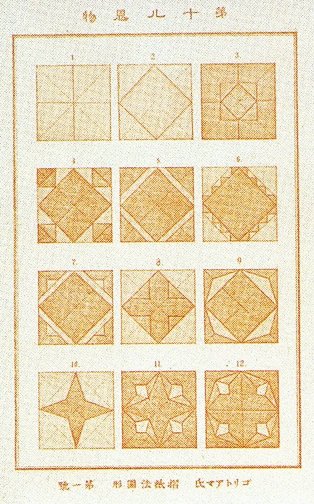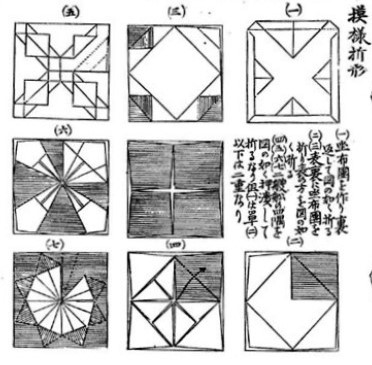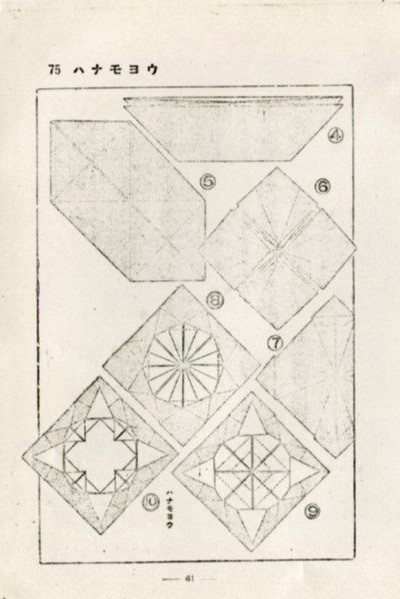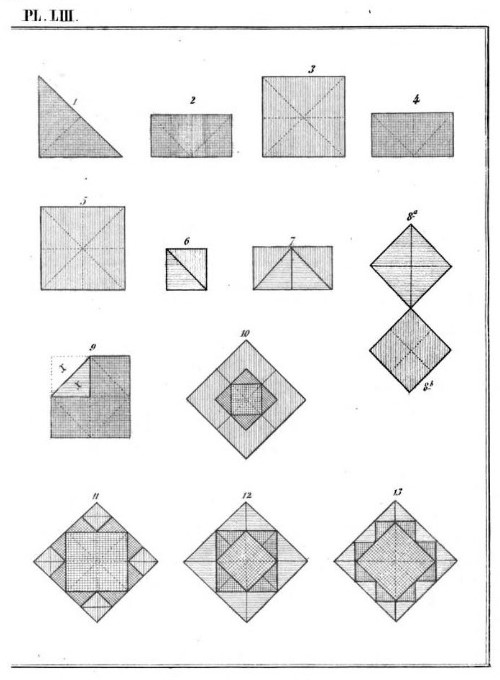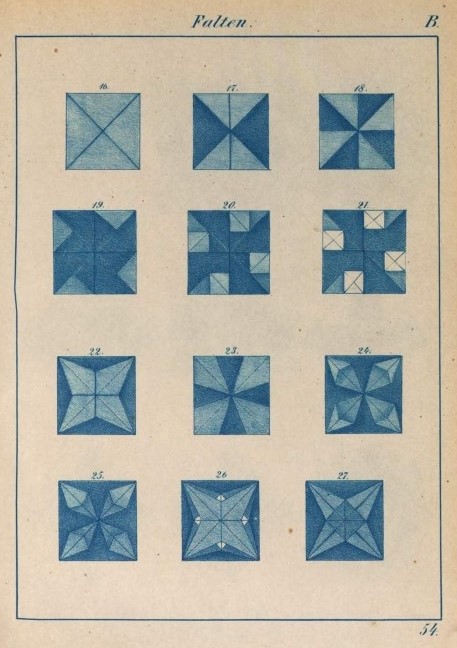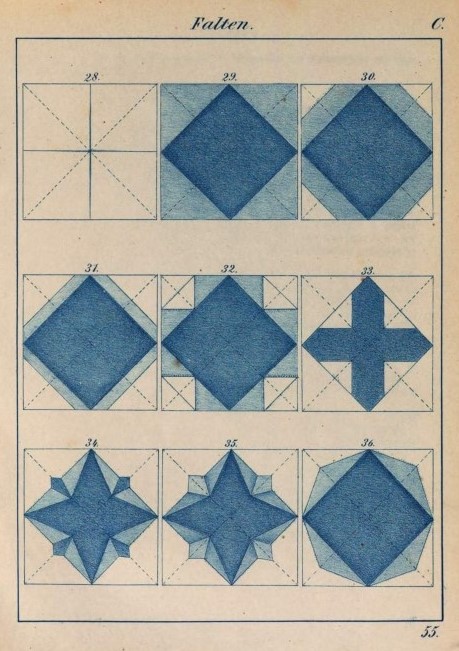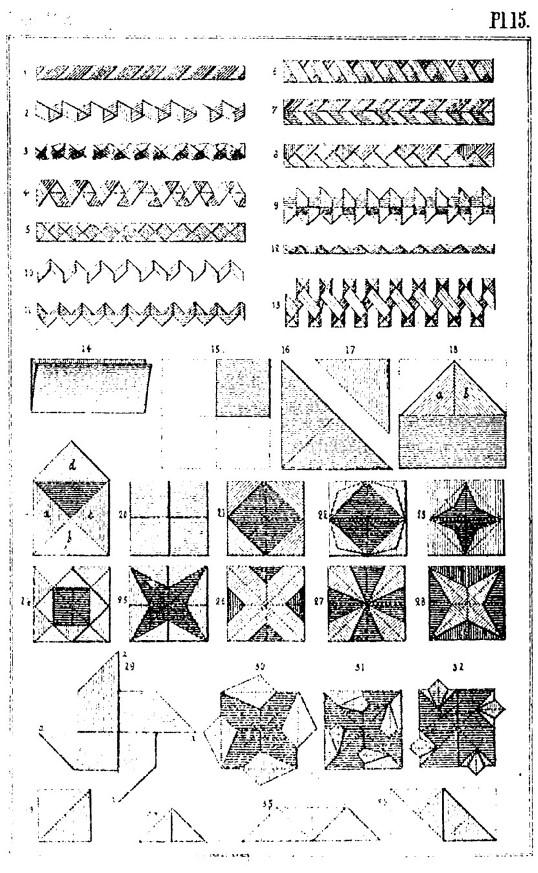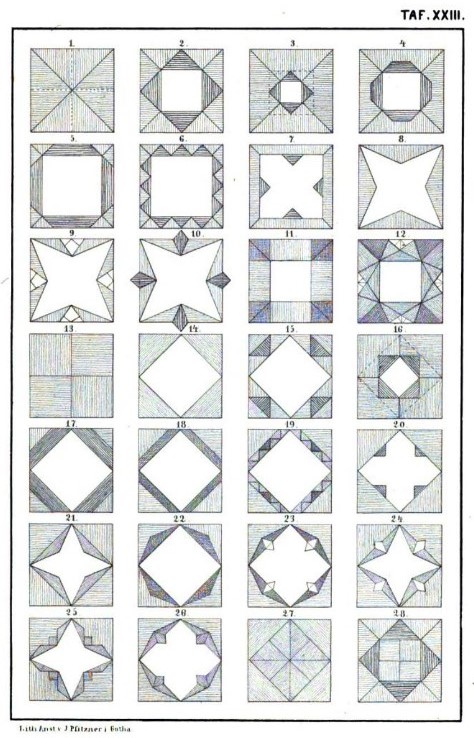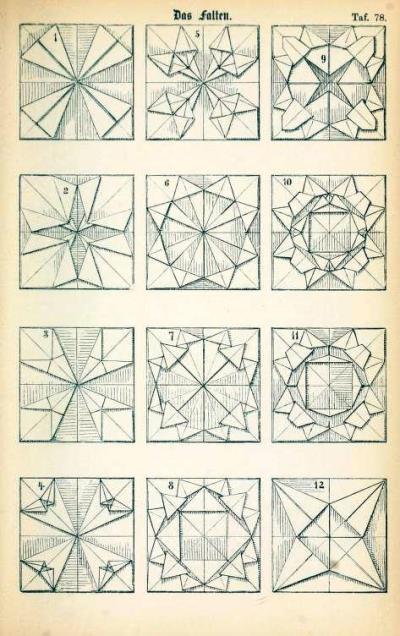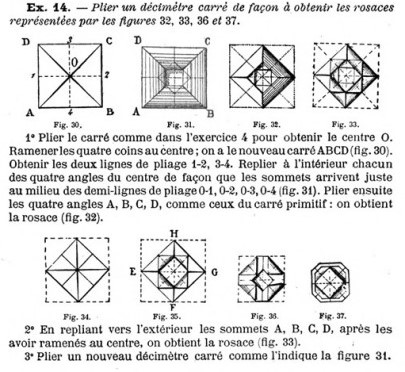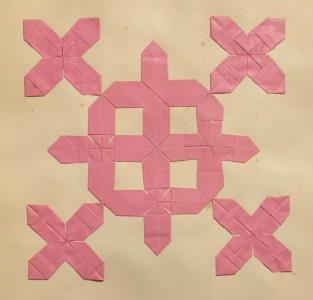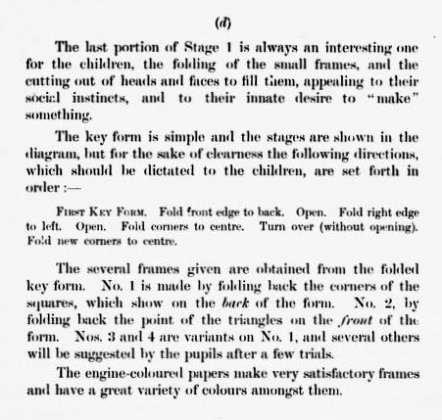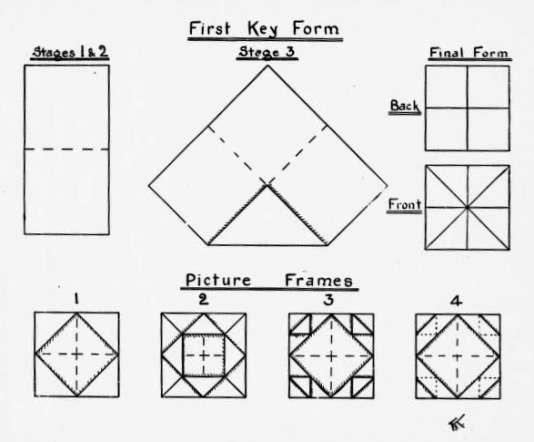| The Public Paperfolding History Project
Last updated 18/7/2024 x |
|||||||
| The Froebelian Occupation of Falten - Schonheitsformen (Forms of Beauty) | |||||||
| This
page is being used to collect information about the
history Schonheitsformen (Forms of Beauty), symmetrical
geometric designs which were folded in the Kindergarten
as part of the Froebelian occupation of Falten
(paperfolding). Please contact me if you know any of this
information is incorrect or if you have any other
information that should be added. Thank you. I have not made a study of the various Fold of Beauty forms, given them standard names or generally recorded them on individual pages. There is, however, a separate page for the Four Rhombi design, which could be considered a Form of Beauty. ********** In Japan (and in publications by Japanese authors) 1878 'Yochien Ombutsu No Zu' (Illustrations of Kindergarten Gifts), which was published in 1878 by the Tokyo Women's Normal School, contains four pages of illustrations of Forms of Beauty. These were redrawn from illustrations in the 1874 edition of 'Der Kindergarten' by Hermann Goldammer.
********** 1905 Diagrams for folding several Forms of Beauty appear in 'Shukouka Kyohon : Liron Jishuu Souga Setsumei' by Kikujiro Kiuchi, Rokushiro Uehara and Hideyoshi Okayama, which was published by Shigebei Takase in Chiba in 1905.
********** Diagrams for several Forms of Beauty also appear in 'Shukoka Kyoju Saian' by Gentaro Tanahashi and Hideyoshi Okayama, which was published by Hobunkan in Tokyo in 1905.
********** 1944 A few patterns derived from the Windmill Base appear in 'Origami Shuko' by Isao Honda, which was published in 1944.
********** In Europe and the Americas 1859 As far as I know Froebelian Forms of Beauty, here called 'figures artistique', first appear in 'Manuel pratique des jardins d'enfants de Frédéric Froebel', which was compiled by J F Jacobs and published by F Claassen in Brussells and L Hachette and Cie in Paris in 1859. Plate LIII below shows four Forms of Beauty developed from the Double Blintz Basic Form (a square that has been blintzed, turned over and blintzed again) two from one side and two from the other (pictures 10 to 13).
********** 1861 'Das Paradies der Kindheit' (The Paradise of Childhood) by Lina Morgenstern, which was published in Leipzig in 1861, contains a chapter on Das Papierfalten which briefly refers to 'Schonheitsformen' (Forms of Beauty), and provides a list which translates, roughly, as 'the Simple Flower, the Star, the Rose, the Filled Rose, the Rosette etc.' Unfortunately there are no illustrations to allow us to identify what these forms looked like. ********** 1862 'Das Frobel'sche Faltblatt' (Frobel's Folding Sheet) ) by August Kohler, which was published by Hermann Bohlau in Weimar in 1862, is a guide to the use of a series of paperfolds to teach geometrical ideas in the kindergarten. The main sequence begins with the unfolded square and ends with the Double Blintz Basic Form, at which point the author comments, roughly, 'We finally get the basic form ... from which one can learn the most varied forms of life and beauty ...' However no examples of such forms are given in the book. ********** 1869 'Der Kindergarten' by Hermann Goldammer, which was published by Habel in Berlin in 1869, contains two plates which illustrate 'Schonheitsformen' (Form of Beauty) developed from the blintzed square, the Windmill Base and the Double Blintz Basic Form.
********** The same illustrations are to be found in 'Paradise of Childhood' by Edward Wiebe, which was published by Milton, Bradley and Company in Springfield, Massachusetts, also in 1869. ********** 1873 'Exercices et Travaux pour les Enfants Selon la Méthode et les Procédés de Pestalozzi et de Froebel' by Fanny and Charles Delon, which was published by Librairie Hachette in Paris in 1873, contains illustrations of Forms of Beauty developed from the Double Blintz Basic Fold, the windmill Base and the Windmill.
********** Pictures 1 and 13 of Plate XXIII of 'Die Praxis Des Kindergartens' by Auguste Koehler, which was published by Herman Bohlau in Weimar in 1873, show the two sides of the Double Blintz Basic Form from the two sides of which which patterns 2 to 12 and 14 to 28 can be derived. Pictures 27 and 28 show two more complex groundforms from which other patterns can be derived.
********** Schonheitsformen (Forms of Beauty) also appear in: 1874 The third edition of 'Der Kindergarten' by Hermann Goldammer, which was published by Carl Babel in Berlin in 1874, contains three plates picturing various Forms of Beauty. Plate 41 series A shows forms developed from one side of the Double Blintz Basic Form and Plate 41 series B shows forms developed from the other side. Plates 42 and 43 show forms developed from the Windmill Base. ********** 'Spiel und Arbeit' by Hugo Elm, which was published by Verlag und Drud der Otto Spamer in Leipzig in 1874. There are six plates showing folds of beauty designs.
********** 1880 'The Kindergarten Principle' by Mary J Lyschinska, which was published in London in 1880 by Wm Isbister Ltd contains a small section devoted to Forms of Beauty under the name of 'Symmetrical Forms'. ********** 1882 'The Kindergarten Guide' by Maria Kraus Boelte and John Kraus, which was first published in single volume form by E. Steiger and Company in New York in 1882, shows how to fold 'forms of symmetry; from squares, oblongs and equilateral triangles. The book also explains how to take some osimple forms and use them as tiles to create larger, compound designs. ********** 'Le Travail Manuel a L'ecole Primaire' by Jully & Rocheron, which was published by Librairie Classique Eugene Belin in Paris in 1892. ********** 1883 'Der Kindergarten' by A S Fischer, which was published by Alfred Holder in Wien in 1883, contains a plate showing designs which are developable from a simple blintzed square by manipulating the blintzes. ********** 1887 Part 2 'Die Praxis' of 'Theoretisches und praktisches Handbuch der Fröbelschen Erziehungslehre' by Bertha von Marentholtz-Bülow, which was published by George H Wigand in Kassel in 1887. ********** 'Cours de Travail Manuel (Pour les Garcons) - Premiere Partie - Cours Elementaire' by A Planty, which was published by Gedalge Jeune in Paris in 1887. ********** 1890 Diagrams for several simple 'rosaces' appear in 'Les travaux manuels a l'ecole primaire a l'usage des ecoles de garcons' by Dauzat and Deramond, which was published by Alcide, Picard et Kaan in Paris in 1890.
********** 1891 'Education of Head and Hand' by Gabriel Bamberger, which was published by A Flanagan in Chicago in 1891, is a compilation of six leaflets about manual work in schools. The first leaflet is about how to fold Froebelian Forms of Beauty, although no mention of Froebel is made. ********** 1893 'Practical Suggestions for Kindergartners, Primary Teachers and Mothers' by Jeannette R Gregory was published by C B Woodward and Co in St Louis in 1893. It provides a programme of work for each of the 40 weeks of the kindergarten year, many of which include paperfolding elements, including some Folds of Beauty.
********* 'Paper and Scissors in the Schoolroom' by Emily Weaver, which was published by Milton Bradley Company in Springfield, Massachusetts in 1893 contains severalpages explaining various Folds of Beauty. ********** 1894 'Jeux et Occupations Pour les Petits: Guide des Mčres et des Institutrices' by Henriette Suzanne Brés, which was published by Librairie Classique Fernand Nathan in Paris in 1894 contains illustrations of designs developed from the blintzed square and the Double Blintz Basic Form. ********** 'Old Glory: The Flag of Our Country: A Study in History and a Lesson in Paperfolding: Also Some Easy Lessons in Cutting and Folding' by Dr Albert Elias Maltby, which was published in Slippery Rock, Pennsylvania in 1894, contains a section about Folds of Beauty. ********** 1895 Eleonore Heerwart's 'Course in Paperfolding', which was first published in Dutch in 1895 then in English by Charles and Dible in London and Glasgow in 1896, contains many plates illustrating Forms of Beauty folded from squares, hexagons, equilateral triangles, rhombi and pentagons. ********** A sample book of Froebelian paperfolds and papercuts etc made by by Laura B Thompson in 1895 contains examples of several Folds of Beauty and the ways in which they can be arranged to form patterms.
********** 'L'enseignement manuel dans les ecoles du degre primaire (garcons)' by Rene Leblanc was published by Librairie Larousse in Paris in 1895. ********** 'Geometrie, Dessin et Travaux Manuels - Cours Moyen', produced under the direction of M E. Cazes, was published by Librairie Ch. Delagrave in Paris in 1895. ********** 1898 'Travaux Recreatifs Pour les Enfants de 4 a 10 Ans' by Marie Koenig, which was published by Librairie Hachette et Cie in Paris in 1898 contains two pages of craft activities using a basic 'forms of beauty' design. ********** 1900 'Introduccion a la Ensenaza Practica del Sistema de Kindergarten' by Ernesto Steiger, which was published by E Steiger and Co in New York in 1900. ********** 1909 A number of square patterns developed from the Double Blintz Basic Form appear in 'Petit Manuel de Travaux d'Amateurs' by H de Graffigny, which was published by Collection A L Guyot in Paris in 1909. ********** 1910 Part 2 'Das Flechten' of 'Die Frobelschen Beschaftigungen' by Marie Muller-Wunderlich, which was published by Friedrich Brandstetter in Leipzig in 1910. ********** Folds of Beauty are referred to as 'Frames' in 'Educational Handwork' by T B Kidner, which was published by The Educational Book Company Limited in Toronto in 1910.
********** 1914 A number of basic patterns folded from the blintzed square and the windmill base appear in 'El Trabajo Manual en la Escuela' by Félix Martí Alpera, which was published by Libreria de los Sucesores de Hernando in Madrid in 1914. ********** |
|||||||
